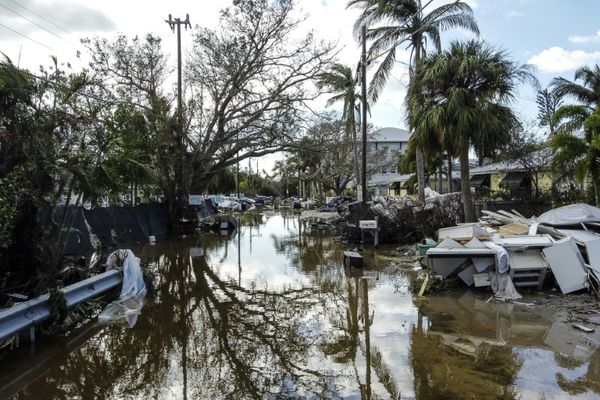STERLING HEIGHTS, Michigan — The maker of Jeep SUVs and Ram pickup trucks is partnering with DTE Energy Co. to add 400 megawatts of solar energy generation to power dozens of sites in southeast Michigan and the production of all of its vehicles in the state.
The plan is a part of Stellantis NV's commitment to achieve carbon net-zero status globally by 2038. With the addition of the solar power through DTE's MIGreenPower program, Stellantis says it will be able to attribute all electricity use at 70 manufacturing and non-manufacturing sites to solar by 2026.
That doesn't mean the facilities will be powered every minute of the day by solar since the sun doesn't shine 24/7, DTE CEO Jerry Norcia says, but the project will be able to produce the equivalent amount of energy that Stellantis uses in a year. DTE last month shared details of its proposed 20-year plan that would accelerate the end of coal energy production to 2035 and increase its mix of renewable energy into the grid to 60%, up from today's 20%, while seeking to sustain energy reliability. In addition to wind and solar, DTE uses natural gas and zero-emission nuclear sources.
"This plan demonstrates our commitment to getting as clean as fast as we can, while providing reliable and affordable energy," Norcia said. "And reliable is No. 1, because we need to keep plants like this running. The lights need to stay on as we transition to cleaner sources of energy."
The addition for Stellantis could power approximately 130,000 homes annually and will avoid close to 740,000 tons (670,000 metric tons) of carbon dioxide emissions every year. After completion, the company will have reduced carbon emissions in North America by 50% and across its manufacturing facilities by 30%.
"We have an awful lot to be thankful for," Mark Stewart, Stellantis' chief operating officer in North America, said. "And it's about these partnerships that we've had together for all these years. And it's the journey that we continue to be on to find ways to be better, to serve our customers better and to do better things for the environment."
The solar project is the second largest of its kind in the United States, according to the companies, citing data from Bloomberg. The largest is DTE's partnership with Ford Motor Co. announced in August to add 650 megawatts of new solar energy in the state.
Although the announcement is a step forward for Stellantis, its sustainability report suggests emissions from company activities are a sliver of its carbon footprint; they are less than 2% in Europe. An overwhelming majority of its emissions there — 85% — come from the vehicles it sells to customers. In South America, Stellantis also already has neutralized 55% of its plants' power sources.
Stellantis' 2030 Dare Forward strategy seeks to transform the automaker into a sustainable tech mobility company. It says it will launch 25 all-electric vehicles in North America by the end of the decade — none of which have hit the market yet.
DTE's MIGreenPower is a voluntary renewable energy program. To date, more than 800 businesses and 75,000 residential customers have enrolled of DTE's 2.3 million electricity customers. MIGreenPower participants have employed 4 million megawatt hours of clean energy in the program, the equivalent of avoiding more than 3 million tons of carbon dioxide emissions annually.
The Stellantis arrays will require about 2,000 acres of land. They'll be located on DTE property as well as Stellantis parcels and building rooftops. Their construction, which is expected to begin in 2024, will create hundreds of jobs and long-term rely on 10 to 15 workers, according to the Detroit-based utility.
The remarks were made during a news conference at the Sterling Heights Assembly Plant, the home to the Ram 1500 pickup truck, one of Stellantis' least fuel efficient vehicles. The automaker is set to debut an all-electric concept of the 1500 called the Ram Revolution in early January at the CES consumer electronics trade show in Las Vegas. A production model will launch in 2024. The company hasn't said where that will be built.
"There's over 7,000 employees that work here, and when you think of the economic impact of those 7,000 employees, it's over a billion dollars," said Mark Vanderpool, Sterling Heights' city manager. "For every one manufacturing job here, it creates four other jobs in the economy. That's the $1 billion impact. That's why sustainability is so important, kind of selfishly, from the city's perspective."
James Gholston, the plant manager in Sterling Heights, said Stellantis facilities already have achieved more than 9,400 megawatt hours of operational energy savings, the equivalent of 810 million smartphones, that has saved the automaker $1.8 million annually. Ultimately, it was determined a plan encompassing all of Stellantis' facilities in the region would create a larger impact than locations individually.
"We often talk about the workers and the work that we do, but I have to tell you, looking at what we're seeing in the future here in Macomb County, it's gone beyond that now," said Mark Hackel, the county's executive. "It's not just great vehicles, a great product, but now we're going to be doing it and making sure that we're producing clean, renewable energy, and thanks to DTE for making that happen."







